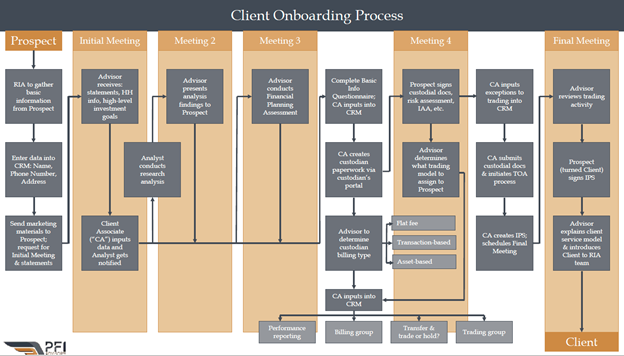In our work with large RIAs looking to increase their scale and efficiency, we often begin with a review of their various systems, people, and processes. We walk through a comprehensive list of their executives, advisors, and employees to better understand the broader team’s roles and responsibilities. We then begin to dive deeper to gather knowledge in what formal, memorialized workflows they have in place. Oftentimes, RIAs have a general set of steps they take to onboard new clients or to service existing clients, but they rarely have deeply mapped out workflows covering multiple systems, roles/teams, or functions. Where should they start?
First, RIAs should compose a comprehensive list of their entire team, including executives/owners, advisors, and support staff. All titles, responsibilities, and basic functions should be included in this list, and eventually it should be mapped out in a way that indicates what team they are part of and how they relate to everyone else in the firm. Eventually, an org chart with formal job descriptions should be created so it is clear who manages what process in a given organizational function. This better helps the RIA understand exactly what each person is doing, what systems they touch, and how their role plays into the various workflows that are yet to be built. Additionally, this reassures employees that the firm’s leadership fully supports their current role within the firm and are actively thinking of how to best leverage their talent.
Next, whoever is leading the process of mapping out these workflows should start with a basic Word document or Excel spreadsheet to easily organize who is responsible for what task, what system each task is taking place in, what the previous and/or next steps are, whether client involvement is required or not, and how this task relates to all other tasks across the organization. For example, when a client trade request is received, how does the advisor or client service team relay that to the investment and trading team and then how is it properly documented? Once this document is drafted, I find it especially helpful to then use a mapping tool (either static like Omnigraffle or dynamic like monday.com) to visually lay out the intricacies of the workflows.
When clients are involved in any given workflow (like a client onboarding workflow, for example), it should clearly state exactly when the clients are being contacted, what the messaging is, who the person contacting the client will be, and the timeline surrounding the communication in regards to the other tasks that are being executed amongst the team.


Eventually, once the workflows have been reviewed by the various team members and departments within the organization, they should be imported/developed within the RIA’s various systems. While most workflows are often centralized in the CRM, there will be other external systems beyond the CRM that will need to be involved and these processes should be as automated as possible without becoming cumbersome.
The final step in fully developing a firmwide workflow is to memorialize it in the RIA’s operations manual. While an entire manual with tens (often hundreds) of pages may seem overwhelming, if an RIA breaks it down into individual sets of instructions, it becomes much easier to manage as an administrator and comprehend as a new employee. In time, an RIA should have a prospect-to-client workflow, a client onboarding workflow, an ongoing client service model workflow, and (if they are actively seeking to acquire other advisors/RIAs) a new firm onboarding workflow.
Developing workflows doesn’t have to be challenging, but it is time consuming. We feel it is time well spent, however. By developing workflows across all major functions of your business, you ensure an efficient and consistent client experience. The reliability of that experience is what your firm’s brand is built on – it’s what clients have come to expect from your organization and it’s what they tell their friends about when people ask them about their advisor. Your firm’s ability to impress clients and earn the trust of new ones starts with these back office workflows.

